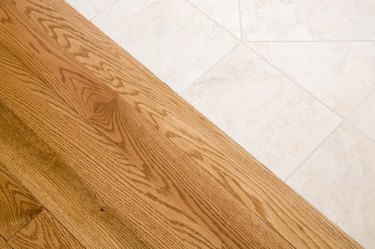
T-molding is used to join flooring, transition from one flooring material to another or as edging along the end of flooring. Most T-molding available is made of plastic, composite or other synthetic materials, although natural wood T-molding is available. Typically, homeowners have the option of securing T-molding with adhesive or by screwing in a channel strip and snapping the top piece in place. Some options require toe screws, or screws inserted at an angle so that the head disappears below the surface of the molding.
Common Uses of T-Molding
Video of the Day
The most common use of T-molding is to transition from one type of flooring material to another. For example, a dining room might have wood flooring while the adjacent kitchen may have tile flooring. If both floors are not at equal height, a strip of T-molding not only covers the seam between floors, but also bridges the gap in height. Other uses include along the edge of flooring near walls, where flooring material may not fully extend to the wall. In such instances, T-molding can cover gaps where the room is out of square.
Video of the Day
High-Traffic Areas
In high-traffic areas, such as doorways or halls, the use of T-molding is common. However, glued T-molding must be able to withstand extreme wear. Repeated abuse from foot traffic, rolling carts and other wear shortens the life of most adhesives. In the case of exterior entryways, exposure to seasonal climate changes can weaken adhesive over time. As such, these applications often benefit from screw-down T-molding.
High-Moisture Areas
Bathrooms, kitchens or any other area frequently exposed to water or moisture are typically better suited to screw-down T-molding systems. Such environments typically feature hard flooring such as tile and must endure frequent mopping, steam and water drips. Just as with heavy foot traffic or exposure to the elements, water will weaken adhesives over time. The result is reduced adhesion and the eventual need for replacement or re-gluing.
Concrete, Stone and Other Floors
While screw-down T-molding is often best for areas with high traffic, exposure to the elements or frequent moist conditions, other flooring materials are unsuitable for screw-down molding. For example, stone or marble tile may not allow for the installation of screwed tracks for snap-in systems. Concrete floors are also ill-suited for T-molding requiring screws. In such environments, glued-down T-molding is the best solution.
Tight Fits, Out of Square or Unconventional Areas
When installing T-molding in areas with limited access, such as along wall edges, around stairs or inside closets, gluing is often easier. Adhesive can be applied before installation and no power tools are required. A room that is out of square and thus shows gaps between the flooring and wall may lack sufficient framing into which screwed tracks can be installed. Other unconventional areas where power tools cannot achieve the appropriate angle are also good candidates for glued-down T-molding systems.